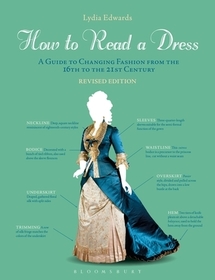
How to Read a Dress
A Guide to Changing Fashion from the 16th to the 21st Century
-
13% KEDVEZMÉNY?
- A kedvezmény csak az 'Értesítés a kedvenc témákról' hírlevelünk címzettjeinek rendeléseire érvényes.
- Kiadói listaár GBP 26.99
-
12 894 Ft (12 280 Ft + 5% áfa)
Az ár azért becsült, mert a rendelés pillanatában nem lehet pontosan tudni, hogy a beérkezéskor milyen lesz a forint árfolyama az adott termék eredeti devizájához képest. Ha a forint romlana, kissé többet, ha javulna, kissé kevesebbet kell majd fizetnie.
- Kedvezmény(ek) 13% (cc. 1 676 Ft off)
- Kedvezményes ár 11 218 Ft (10 684 Ft + 5% áfa)
Iratkozzon fel most és részesüljön kedvezőbb árainkból!
Feliratkozom
12 894 Ft

Beszerezhetőség
Becsült beszerzési idő: A Prosperónál jelenleg nincsen raktáron, de a kiadónál igen. Beszerzés kb. 3-5 hét..
A Prosperónál jelenleg nincsen raktáron.
Why don't you give exact delivery time?
A beszerzés időigényét az eddigi tapasztalatokra alapozva adjuk meg. Azért becsült, mert a terméket külföldről hozzuk be, így a kiadó kiszolgálásának pillanatnyi gyorsaságától is függ. A megadottnál gyorsabb és lassabb szállítás is elképzelhető, de mindent megteszünk, hogy Ön a lehető leghamarabb jusson hozzá a termékhez.
A termék adatai:
- Kiadás sorszáma 2, Revised
- Kiadó Bloomsbury Publishing (UK)
- Megjelenés dátuma 2021. november 18.
- Kötetek száma Paperback
- ISBN 9781350172210
- Kötéstípus Puhakötés
- Terjedelem280 oldal
- Méret 246x188x20 mm
- Súly 760 g
- Nyelv angol
- Illusztrációk 225 color illus 213
Kategóriák
Hosszú leírás:
Fashion is ever-changing, and while some styles mark a dramatic departure from the past, many exhibit subtle differences from year to year that are not always easily identifiable. With overviews of each key period and detailed illustrations for each new style, How to Read a Dress is an appealing and accessible guide to women's fashion across five centuries. Each entry includes annotated color images of historical garments, outlining important features and highlighting how styles have developed over time, whether in shape, fabric choice, trimming, or undergarments. Readers learn how garments were constructed and where their inspiration stemmed from at key points in history - as well as how dresses have varied in type, cut, detailing and popularity according to the occasion and the class, age and social status of the wearer.
This new edition includes additional styles to illustrate and explain the journey between one style and another; larger images to allow closer investigation of details of dress; examples of lower and working-class, as well as middle-class, clothing; and a completely new chapter covering the 1980s to 2020. The latter demonstrates how the late 20th century and early 21st century firmly left the dress behind as a requirement, but retained it as a perennially popular choice and illustrates how far the traditional boundaries of 'the dress' have been pushed (even including reference to a newly non-binary appreciation of the garment), and the intellectual shifts in the way women's fashion is both inspired and inspires.
With these new additions, How to Read a Dress, revised edition, presents a complete and up-to-date picture of 'the dress' in all its forms, across the centuries, and taking into account different sartorial and social experiences. It is the ideal tool for anyone who has ever wanted to know their cartridge pleats from their Rï¿1⁄2camier ruffles. Equipping the reader with all the information they need to 'read' a dress, this is the ultimate guide for students, researchers, and anyone interested in historical fashion.
Tartalomjegyzék:
Acknowledgements
Preface
Introduction
1. 1550 - 1600
2. 1600 - 1699
3. 1710 - 1790
4. 1790 - 1837
5. 1837 - 1869
6. 1870 - 1889
7. 1890 - 1916
8. 1918 - 1929
9. 1930 - 1946
10. 1947 - 1959
11. 1960 - 1979
12. 1980 - 2020
Glossary of Terms
Notes
Bibliography
Photographic Credits
Index
List of Fashion Designers




